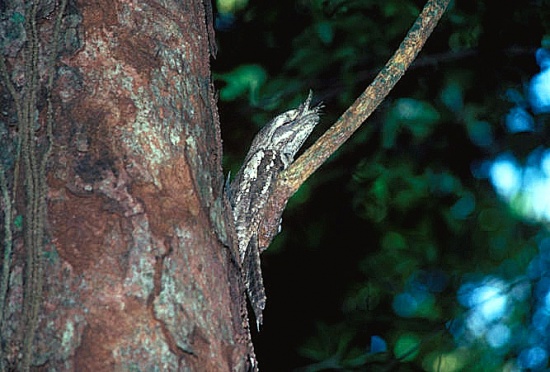- Podargus ocellatus
Identification
Location: Iron Range/Cape York Peninsula/Far North Queensland
Scientific name: Podargus ocellatus Conservation status in NSW: Vulnerable
Description The Marbled Frogmouth is a small to medium sized frogmouth with rich brown plumage delicately flecked and peppered with black and white. It has a long, graduated tail and prominent tuft of cream and chestnut banded plumes protruding above the bill. The species has a loud bubbling, gobbling territorial call ending with a bill clap and a softer “koo-loo” contact call. It can be distinguished from the more common and widespread Tawny Frogmouth by its longer tail, finely patterned plumage and distinctive call.
Location and habitat Distribution Two widely separated races occur with one confined to Cape York Peninsula and other found between Gladstone in south-east Queensland and Lismore in north-east NSW. Its NSW distribution extends west to the upper Clarence River and it is generally rare.
Habitat and ecology Prefers subtropical rainforest spending most time in deep, wet, sheltered gullies frequently containing stands of Bangalow Palms. Less frequently it occurs in higher elevation temperate rainforests and wet eucalypt forest with a well-developed rainforest understorey. Regional information This species is found in the following catchment management authority regions. Click on a region name to see more details about the distribution, vegetation types and habitat preference of the species in that region.
Threats Isolation of patches of habitat due to frequent burning of connecting forest. Clearing, fragmentation and isolation of rainforest and wet eucalypt forest from agricultural and forestry activities. Opening of the canopy and promotion of dense understorey growth caused by timber harvesting. Invasion of habitat by weeds following disturbance. Recovery strategies Priority actions are the specific, practical things that must be done to recover a threatened species, population or ecological community. The Department of Environment and Conservation has identified 11 priority actions to help recover the Marbled Frogmouth in New South Wales.
What needs to be done to recover this species? Protect forest connecting areas of known habitat from frequent fire. Fence areas of known habitat to exclude stock. Assist with removal of weeds in areas of known and potential habitat. Protect known and potential habitat from clearing, fragmentation and isolation. Reconnect patches of known habitat with wide corridors including streamside areas.




